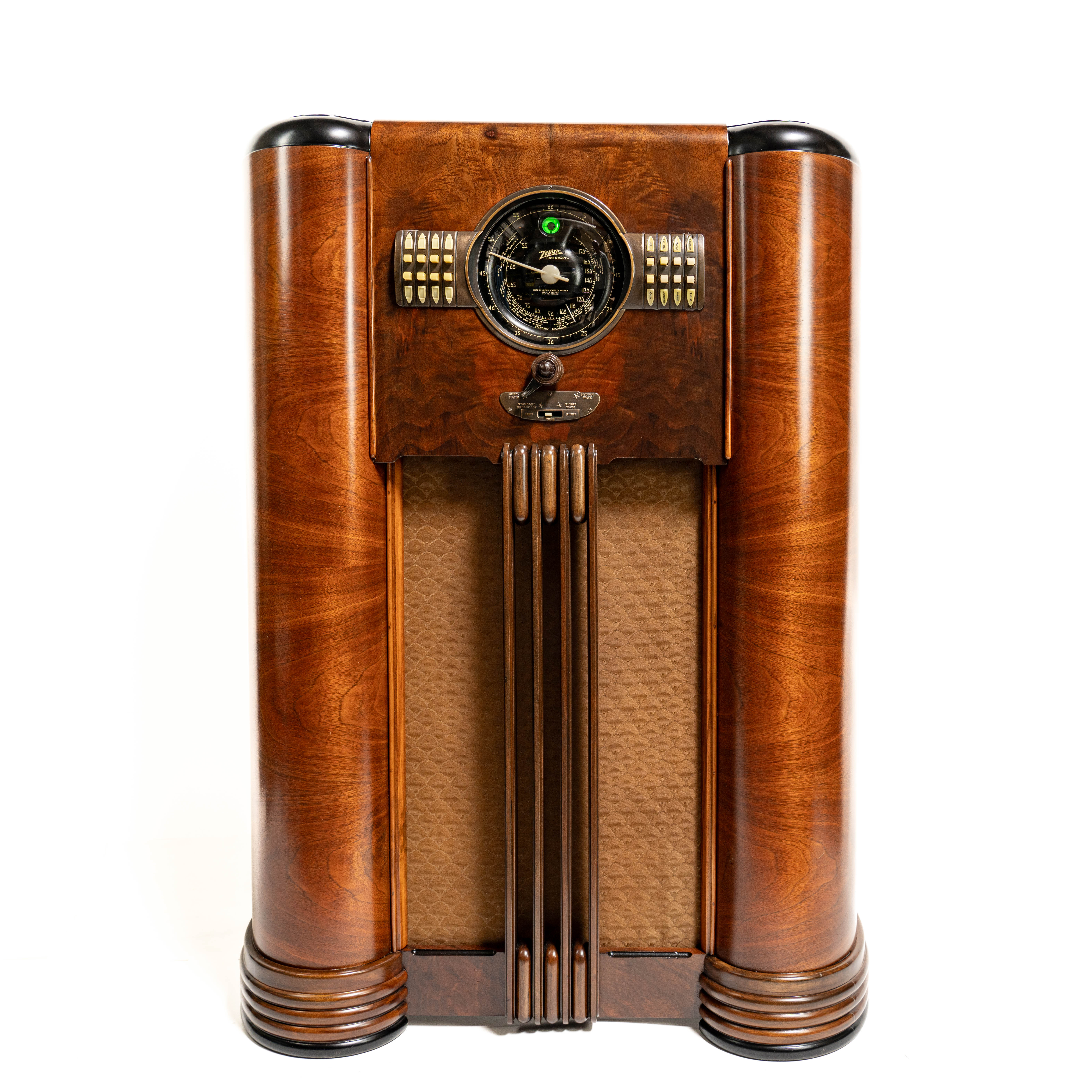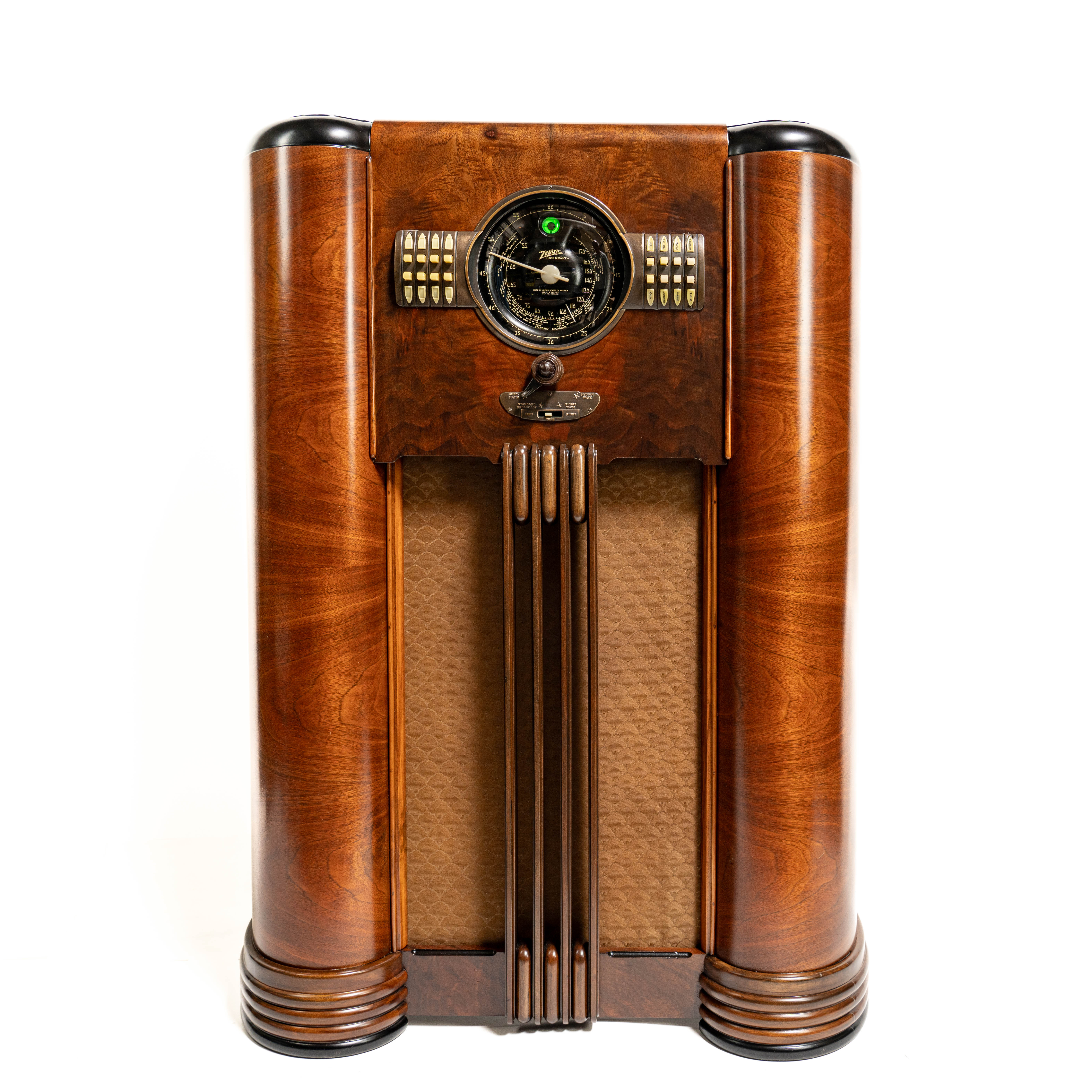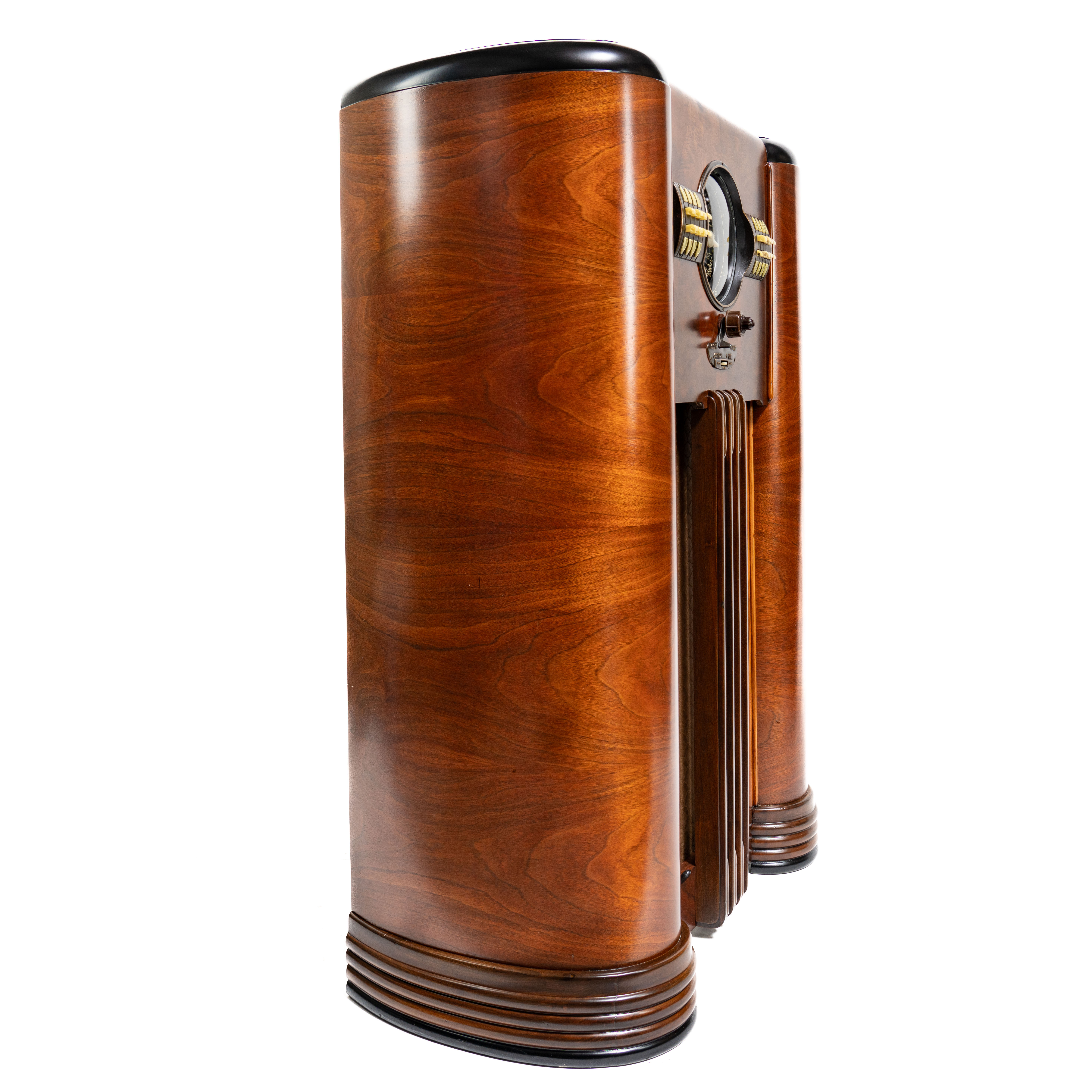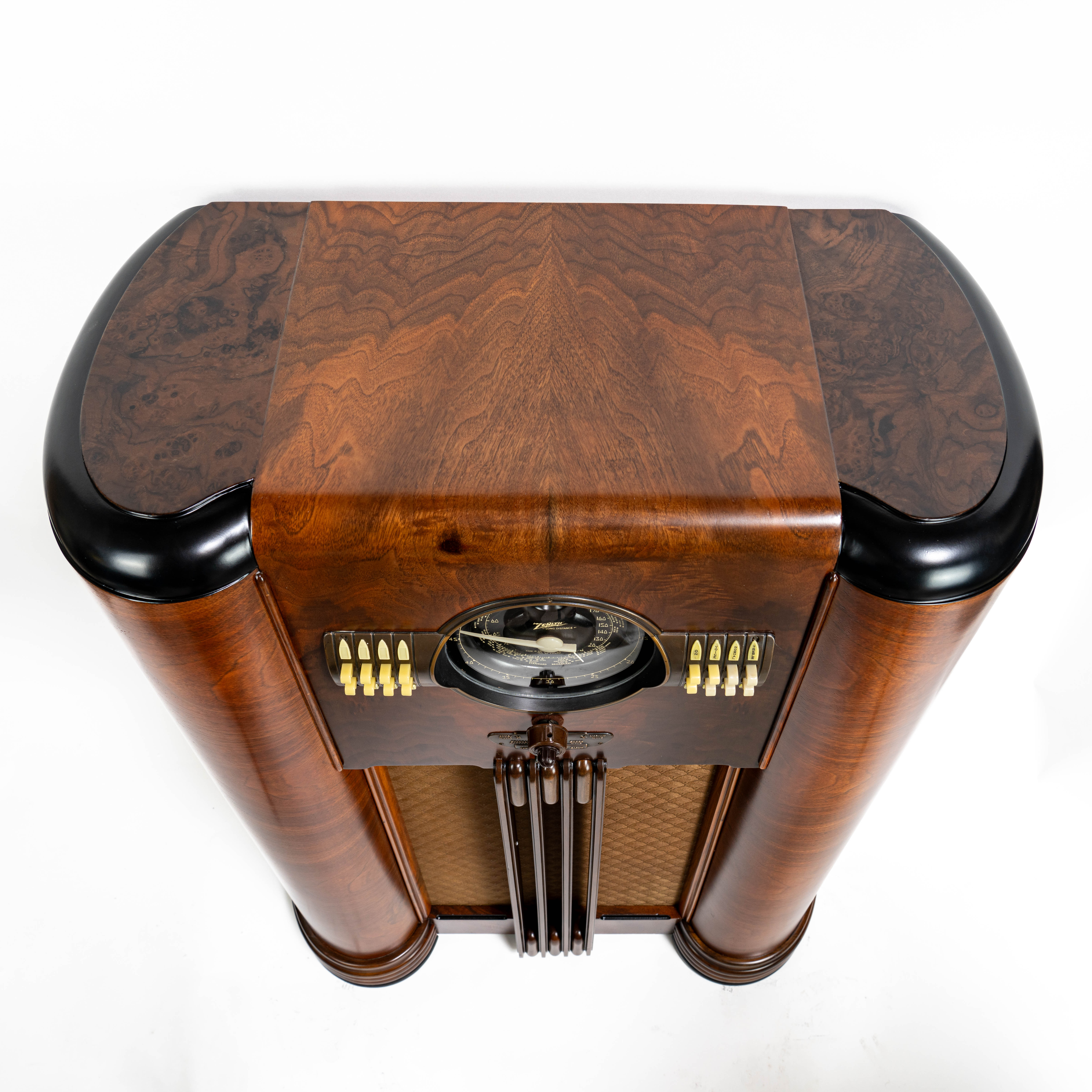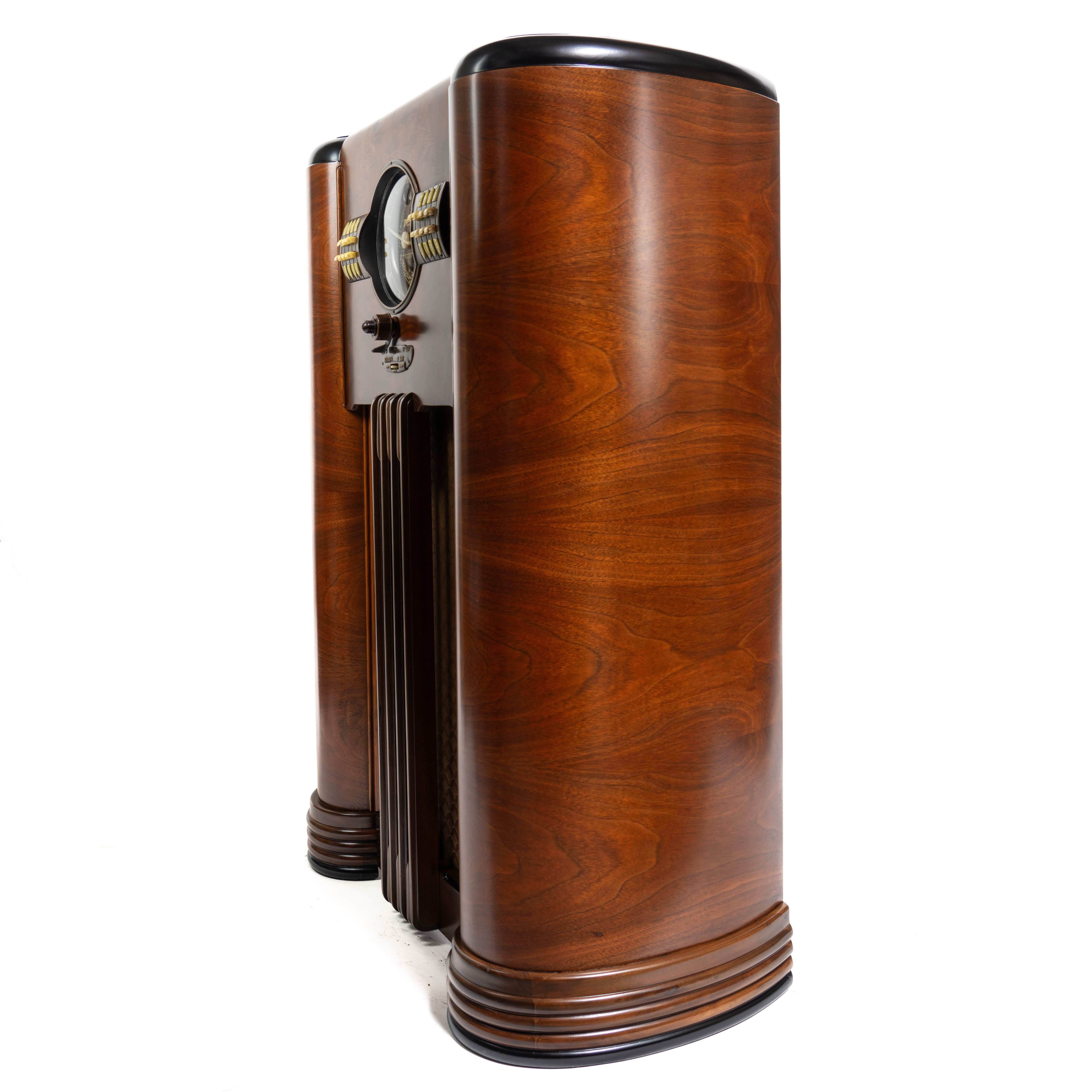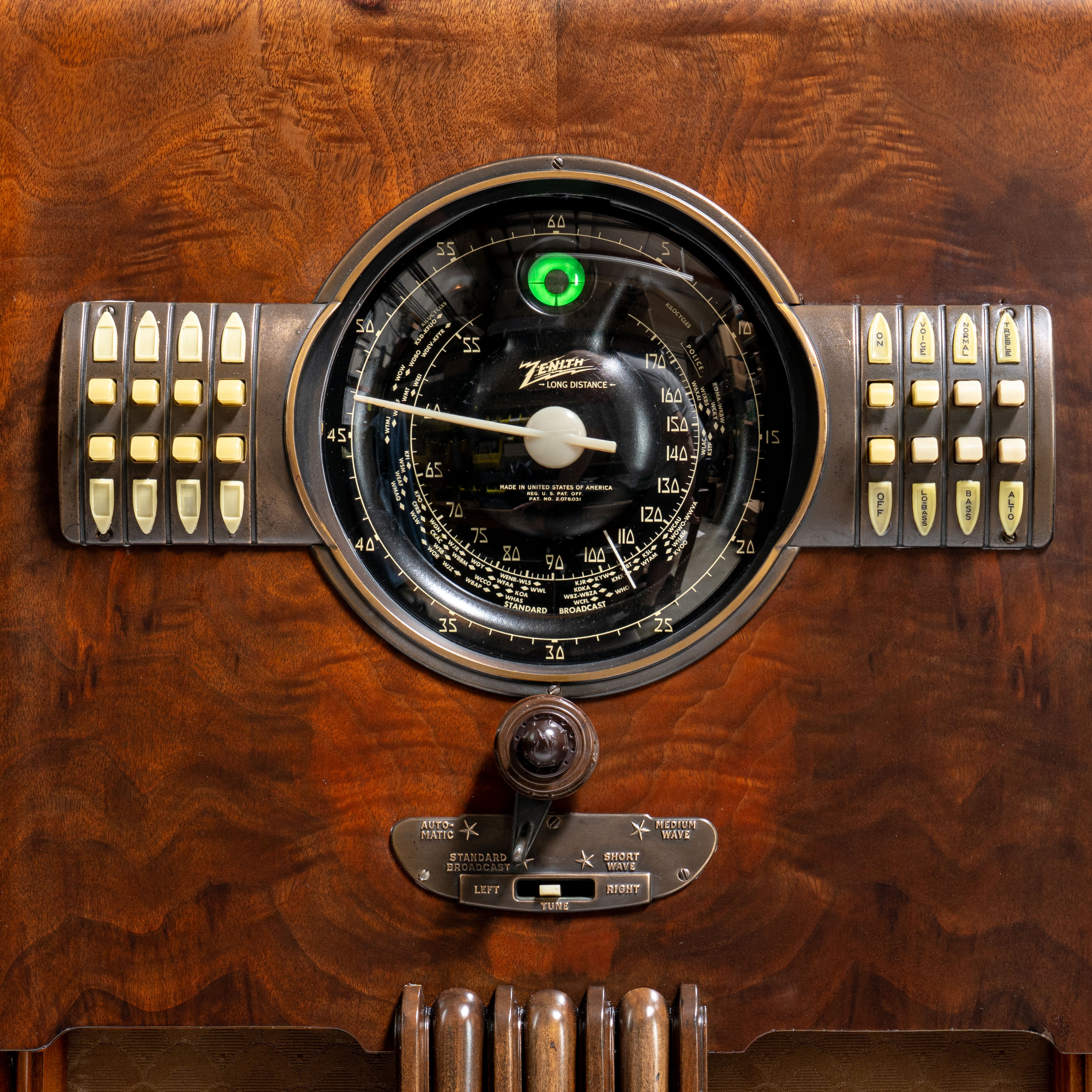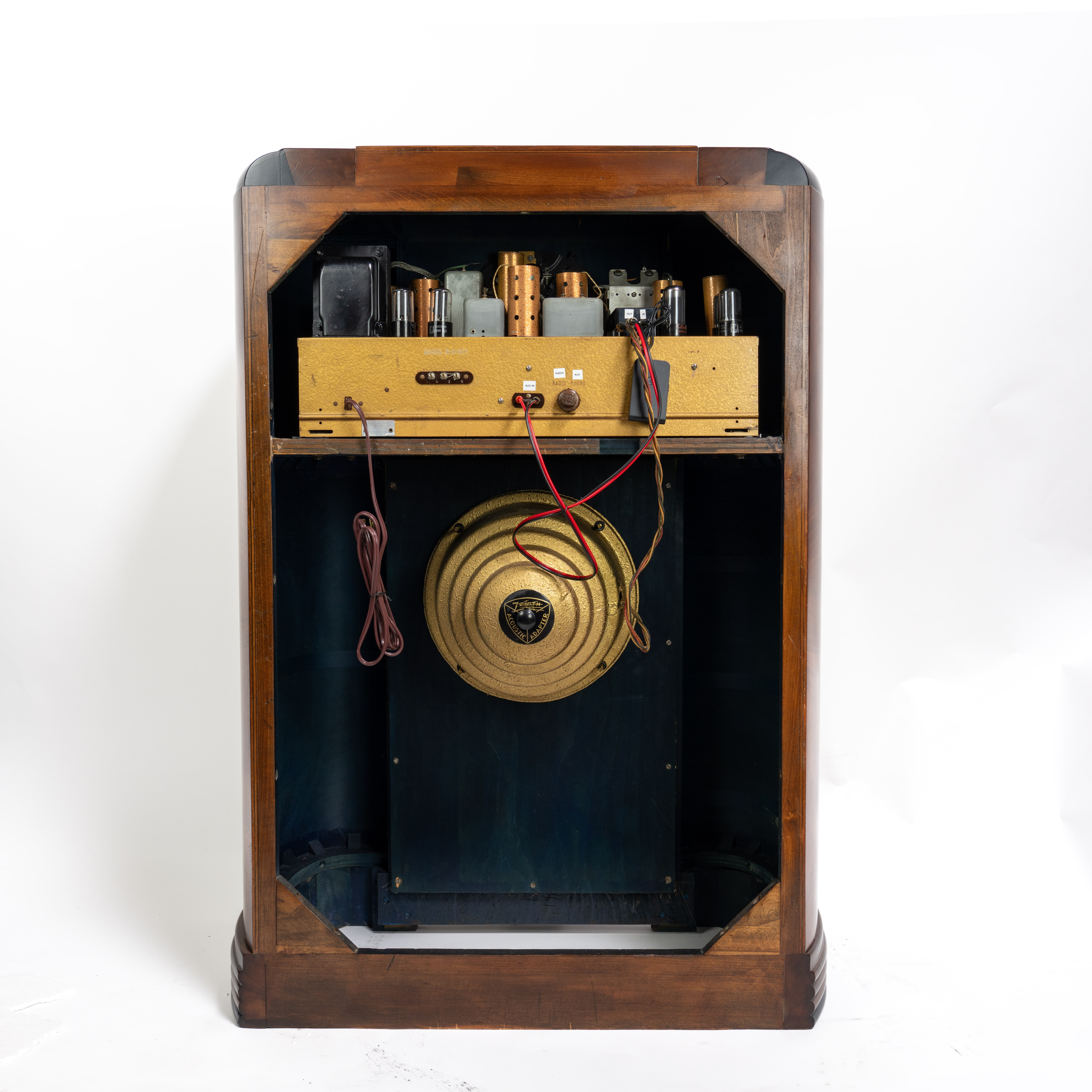- Radios
- >
- Zenith 15S372 Console (1939)
Zenith 15S372 Console (1939)
SKU:
$3,800.00
$3,800.00
Unavailable
per item
SOLD
This rare 1939 Zenith 15S372 console radio is an excellent example of American craftsmanship from a bygone era. This is one of Zenith’s most collectible high-end models. It is a 15-tube, three-band radio sporting the innovative “Robot Shutter Dial” and green magic-eye tuning indicator. It has a dual stage push-pull audio amplifier utilizing four 6V6 output tubes. The rich output rivals high-end audio amplifiers. Coupled with its big 12-inch speaker this console is a room pounder. The cabinets’ book-matched walnut veneer was beautifully refinished with a clear satin lacquer finish and toned color trim. This chassis also got a complete electronic restoration and be retrofitted with our exclusive Bluetooth / MP3 input.
History – The Zenith 15-S-372 (15S372) was first introduced in the summer of 1938 as part of Zenith's line-up of 76 new models for 1939. Its introductory price in the East was $200.00. In addition to Zenith's "robot dial", which received a makeover from its inaugural 1938 model year, the 15S372 embodied two Zenith innovations new for 1939. The first was the Radiorgan, comprising 6 pull-tabs to the right of the dial used for controlling tone, with 64 combinations possible (the remaining two tabs to the right of the dial are for on and off). The second new feature was ‘Transcontinental Tip-Touch Automatic Tuning’, allowing instant selection of one of eight preset stations when the band-lever is in the 'automatic' position. Tip-Touch tuning is done electrically by switching in and out tuned circuits dedicated to each preset. Zenith made much of the fact that any standard broadcast station could be selected as a preset, local or distant. This was an advantage over the mechanical systems offered by some other manufacturers, which relied on Automatic-Frequency-Control (AFC) and consequently needed a relatively strong station to be preset in order to work reliably.
The 'Robot Dial' (or as it is sometimes referred to as the ‘Shutter Dial’) operates when the band lever is moved to change between bands. When this occurs an alternate dial or shutter is rotated into view, revealing the markings solely for the chosen band and rendering set operation less confusing for the listener. Zenith advertising claimed that "it's child's play to operate a Zenith” and “a child delights in doing it”, “the Robot Dial is Almost Human”, and “the greatest advancement in ease of tuning since the inception of radio". The Robot Dial also incorporated a motorized tuning device. A lever in the front can be used to rapidly tune up or down the band with the touch of a finger.
Today, this attractive radio is sought after by collectors but seldom found. We acquired this one in early 2019 from a collector who never restored it. The cabinet was in fair shape and had the original finish. The chassis was working but needed a full restoration and upgrade.
Cabinet – The cabinet got a complete restoration. We stripped the original finish and at great expense replaced the faux paper on the top edges with real walnut burl. We toned the top edge and footer with black lacquer. We treated the veneers with wood conditioner and added grain filler throughout to create a smooth, piano-like finish. The entire cabinet was sealed with a flat satin lacquer. This made the original multi-colored veneers and book-matched walnut veneers pop. We added period correct grille cloth and replaced the original control knobs with modern reproductions. The result is this handsome looking radio that will last many, many years into the future.
Dial – For the most part the shutter dial and motor tuning were in good condition. The dial lettering was clear. To prevent fade we sealed it with semi-gloss lacquer. The shutter dial mechanism was disassembled, cleaned, lubricated, aligned, and reassembled. The surrounding brass escutcheon was cleaned only enough to keep the original patina well into the future. The Tip-Touch tuning buttons were falling apart so we replaced them with modern reproductions.
Chassis – We took extra steps and worked with the top expert at the California Historical Radio Society to ensure this radio produces no hum. We went through the entire underside of the chassis replacing all the capacitors, checking, and replacing resistors and wires where needed. It now plays very well across the dial and all bands even with the simplest of antennas. All tubes were checked and replaced where needed with NOS (new old stock) tubes - including the green tuning eye.
We cleaned and lubricated the main tuning capacitor gears and tuning mechanism for smooth tuning operation. The old tuning belts were worn so we replaced them with new ones. We added a new power cord, fuse and voltage dropping resistor for electrical safety. New silicone rubber chassis mounts were added for better vibration isolation. This radio already had an auxiliary input and switch on the back, so we created connecting cords for it and aligned the radio for the Bluetooth adapter.
Speaker – Even though it performed well, we had the all-original 12-inch speaker cleaned and reinforced. The result is clear audio across the entire audio frequency range. This radio produces exceptional bass tones for its size and the great sound will fill the room.
This radio comes with Zenith's "Acoustic Adapter" movable speaker cover (aka the beehive) that acts as a "tone balancer" to insure sharp, crisp, clear reproduction in any room. We did some minor repairs and gave it a fresh coat of gold glitter paint to match the original color.
Bluetooth - Additionally, this radio has been fitted with our custom Bluetooth / MP3 adapter which allows you to switch between the radio or your smartphone or music device. Access your streaming audio service or the playlist on your smart device to provide classic tunes and bring the warm, bright, analogue sound to any music or recording you choose. The quality of the sound is excellent. You will have the best of “digital” and “analogue” combined.
Year of Manufacture: 1938/1939
Band Frequency Ranges:
AM Broadcast Band..............540 – 1750 KHz
Shortwave Band 1……………….2.2 – 7.8 MHz
Shortwave Band 2……………….7.5 – 25 MHz
Dimensions: 31.5”W x 44.5”H x 16”D
Weight: 72 pounds
Watch video demonstration on YouTube here: youtu.be/SJuzKek8EBg
History – The Zenith 15-S-372 (15S372) was first introduced in the summer of 1938 as part of Zenith's line-up of 76 new models for 1939. Its introductory price in the East was $200.00. In addition to Zenith's "robot dial", which received a makeover from its inaugural 1938 model year, the 15S372 embodied two Zenith innovations new for 1939. The first was the Radiorgan, comprising 6 pull-tabs to the right of the dial used for controlling tone, with 64 combinations possible (the remaining two tabs to the right of the dial are for on and off). The second new feature was ‘Transcontinental Tip-Touch Automatic Tuning’, allowing instant selection of one of eight preset stations when the band-lever is in the 'automatic' position. Tip-Touch tuning is done electrically by switching in and out tuned circuits dedicated to each preset. Zenith made much of the fact that any standard broadcast station could be selected as a preset, local or distant. This was an advantage over the mechanical systems offered by some other manufacturers, which relied on Automatic-Frequency-Control (AFC) and consequently needed a relatively strong station to be preset in order to work reliably.
The 'Robot Dial' (or as it is sometimes referred to as the ‘Shutter Dial’) operates when the band lever is moved to change between bands. When this occurs an alternate dial or shutter is rotated into view, revealing the markings solely for the chosen band and rendering set operation less confusing for the listener. Zenith advertising claimed that "it's child's play to operate a Zenith” and “a child delights in doing it”, “the Robot Dial is Almost Human”, and “the greatest advancement in ease of tuning since the inception of radio". The Robot Dial also incorporated a motorized tuning device. A lever in the front can be used to rapidly tune up or down the band with the touch of a finger.
Today, this attractive radio is sought after by collectors but seldom found. We acquired this one in early 2019 from a collector who never restored it. The cabinet was in fair shape and had the original finish. The chassis was working but needed a full restoration and upgrade.
Cabinet – The cabinet got a complete restoration. We stripped the original finish and at great expense replaced the faux paper on the top edges with real walnut burl. We toned the top edge and footer with black lacquer. We treated the veneers with wood conditioner and added grain filler throughout to create a smooth, piano-like finish. The entire cabinet was sealed with a flat satin lacquer. This made the original multi-colored veneers and book-matched walnut veneers pop. We added period correct grille cloth and replaced the original control knobs with modern reproductions. The result is this handsome looking radio that will last many, many years into the future.
Dial – For the most part the shutter dial and motor tuning were in good condition. The dial lettering was clear. To prevent fade we sealed it with semi-gloss lacquer. The shutter dial mechanism was disassembled, cleaned, lubricated, aligned, and reassembled. The surrounding brass escutcheon was cleaned only enough to keep the original patina well into the future. The Tip-Touch tuning buttons were falling apart so we replaced them with modern reproductions.
Chassis – We took extra steps and worked with the top expert at the California Historical Radio Society to ensure this radio produces no hum. We went through the entire underside of the chassis replacing all the capacitors, checking, and replacing resistors and wires where needed. It now plays very well across the dial and all bands even with the simplest of antennas. All tubes were checked and replaced where needed with NOS (new old stock) tubes - including the green tuning eye.
We cleaned and lubricated the main tuning capacitor gears and tuning mechanism for smooth tuning operation. The old tuning belts were worn so we replaced them with new ones. We added a new power cord, fuse and voltage dropping resistor for electrical safety. New silicone rubber chassis mounts were added for better vibration isolation. This radio already had an auxiliary input and switch on the back, so we created connecting cords for it and aligned the radio for the Bluetooth adapter.
Speaker – Even though it performed well, we had the all-original 12-inch speaker cleaned and reinforced. The result is clear audio across the entire audio frequency range. This radio produces exceptional bass tones for its size and the great sound will fill the room.
This radio comes with Zenith's "Acoustic Adapter" movable speaker cover (aka the beehive) that acts as a "tone balancer" to insure sharp, crisp, clear reproduction in any room. We did some minor repairs and gave it a fresh coat of gold glitter paint to match the original color.
Bluetooth - Additionally, this radio has been fitted with our custom Bluetooth / MP3 adapter which allows you to switch between the radio or your smartphone or music device. Access your streaming audio service or the playlist on your smart device to provide classic tunes and bring the warm, bright, analogue sound to any music or recording you choose. The quality of the sound is excellent. You will have the best of “digital” and “analogue” combined.
Year of Manufacture: 1938/1939
Band Frequency Ranges:
AM Broadcast Band..............540 – 1750 KHz
Shortwave Band 1……………….2.2 – 7.8 MHz
Shortwave Band 2……………….7.5 – 25 MHz
Dimensions: 31.5”W x 44.5”H x 16”D
Weight: 72 pounds
Watch video demonstration on YouTube here: youtu.be/SJuzKek8EBg
